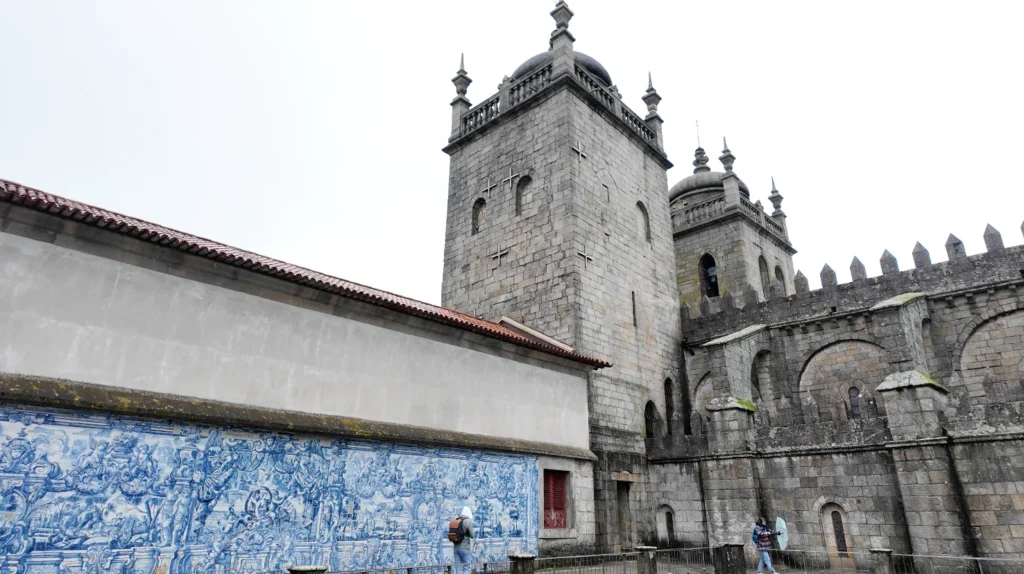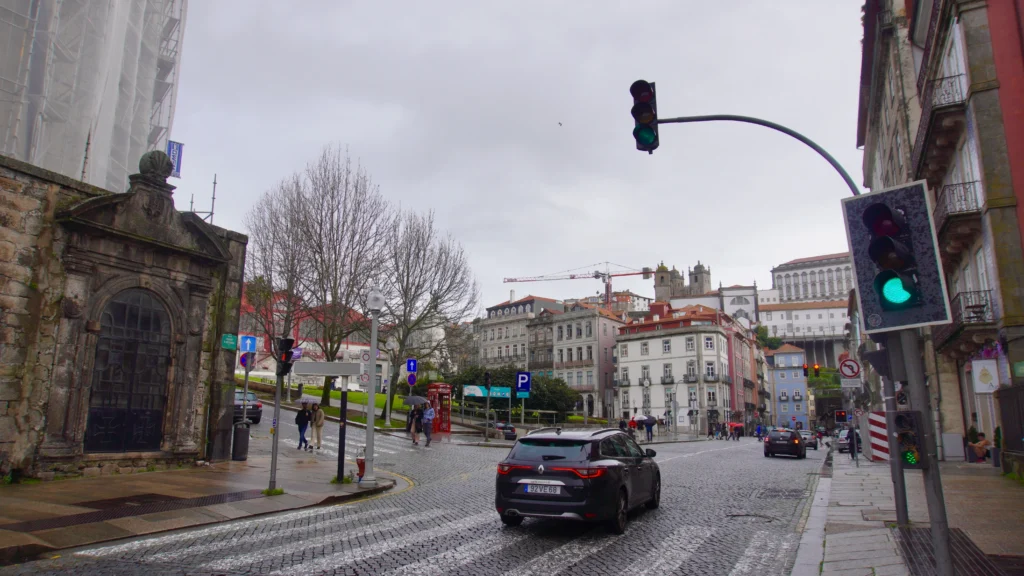The Perfect 3 Day Porto Itinerary (2025)
Are you planning a 3 day getaway to Porto? If so, this article is for you.
Porto is Portugal’s second biggest city after Lisbon, and known for its beautiful historic architecture, Douro River views, and amazing food and wine. From the vibrant culture to the sightseeing opportunities, it was by far the highlight of my Portugal trip.
To help you plan an equally unforgettable trip, this article will cover all of the must-see sites, where to stay, how to get around, and more.
Here is the perfect 3 day Porto itinerary for first timers.
This article contains affiliate links. This means that if you choose to purchase through these links we may earn a commission. This helps keep our content free, at no additional cost to you.

Day 1: Historic Buildings, Food Market, River Views
Start your first full day in Porto seeing the top sites, trying traditional Portuguese foods at a market, and catching the sunset over the Douro River. Here are some of the top sites to see on your first day in the city.
Porto Cathedral

After settling into your hotel, head to the famous Porto Cathedral. This is a magnificent 12th century church with a mix of Gothic and Baroque style architecture.

You can tour the inside to see the cloisters, walls covered in azulejos tiles, and beautiful decorations. It also has a mini tower you can climb up for an amazing panoramic view of the city.

Dom Luis I Bridge

Just down the street from the famous Porto Cathedral, the Dom Luis I Bridge is another must-see site. This is a towering 564 ft tall bridge that crosses over the Douro River, and has an upper and lower portion you can walk across.
The bridge was built by a student of Gustave Eiffel (the engineer behind the Eiffel Tower), making it a site to see in and of itself. It’s worth checking out once you arrive, and returning in the night to see it lit up like the Eiffel Tower!

If you want to see all six bridges that run over the Douro River, go on a river cruise from Porto. This tour includes a walking tour of Porto, and cable car ride down to the river where you’ll begin the cruise
(Note: This takes place in the city, and is separate from the river cruises of the Douro Valley, which is 1.5 hours north of Porto).
Mercado do Bolhão

After sightseeing, head to Mercado do Bolhao to try Portuguese foods. This is a bustling market with a variety of vendors, selling everything from fresh oysters to sandwiches, chocolate, port wine, and souvenirs.
This is the perfect place to stop for lunch or dinner, and it’s open till midnight daily.
Chapel of Souls
The Chapel of Souls is a must-see church, less than a 5 minute walk away from the Bolhao Market. This church is covered in nearly 16,000 azulejos (painted Portuguese blue ceramic tiles), and it’s free to tour the inside.
This is one of Porto’s most popular sites so you may see crowds of tourists, but it’s worth stopping by for the photos!
Other sites where you can see these iconic azulejos tiles are the Igreja do Carmo, Sao Bento train station, and Church of Saint Ildefonso.

Cais Da Ribeira

To end your first night in Porto, enjoy live music and sunset views strolling along Cais da Ribeira.
This is a riverfront promenade with restaurants, bars, gelato shops, and a gorgeous view of the Luis I Bridge. It’s the perfect place to have dinner by the river, and there’s a cable car you can ride to get from the river to the top of the bridge.
Day 2: Douro Valley Wine Tour

On your second day in Porto, go on a full day tour to one of the world’s oldest demarcated wine regions, the Douro Valley. The Douro Valley is where port wine is grown and produced, and it’s only an hour and a half north of Porto.
You can go on a full day Douro Valley tour to see where the grapes are grown, and learn all about the intricate process of port-wine making. This tour provides transportation from Porto, along with lunch, wine-tastings, and a river cruise.
For a full list of options, check out our list of the best port wine-tasting tours.
Port wine is grown and produced solely in the Douro valley, and transported to Vila Nova de Gaia to be stored and aged.

You can also tour port lodges in Vila Nova de Gaia (20 min. walk from Porto), but if you have the time, it’s definitely worth visiting the Douro Valley. There you’ll get to learn about port wine from the producers themselves, and relax away from the hustle and bustle of the city.
Day 3: Peacocks, City Views & Fado
Crystal Palace Gardens

Start your last morning in Porto strolling around the beautiful Crystal Palace Gardens. This is a picturesque riverfront park with manicured gardens, picnic areas, and wild peacocks.

I saw two colorful wild peacocks and chickens roaming around here when I visited, and it had one of the best views of the Douro River. It’s completely free to visit, and is around a 15 minute walk from downtown.

Torre Dos Clerigos

After stopping for breakfast downtown, head to the Torre dos Clerigos. This is an 18th century church with a tower, and one of the first landmarks you’ll see as you arrive in town.

The tower has over 200 narrow winding stairs that you can climb up, for a sweeping view of the city. This is one of Porto’s most interesting attractions, and is definitely worth visiting for the views!
It costs €10/adult to climb up the tower, and they’ll offer to take your picture at the top for a fee.

Livraria Lello

Another must-see site in town is the famous Livraria Lello bookstore. This is an enchanting bookstore with a red spiral staircase, wooden bookshelves, and a stained glass ceiling.
It’s one of the world’s most beautiful bookstores, and although small, it’s worth stopping by for pictures, or to buy a book as a souvenir.

Just remember to buy your ticket online beforehand, and note that the entrance fee is credited towards your book purchase.
Jardim do Morro

As the sun begins to set, head to Jardim do Morro (Garden of the Hill) to enjoy sunset views overlooking the Douro River.
This is a little grassy riverfront park near the top deck of the Luis I bridge, with a gorgeous view of the city during golden hour. It’s only a 10 minute walk from downtown, and there’s a metro stop right next to the park.
Fado Show With Dinner
To end your last night in Porto, attend a live fado show with porto wine. Fado shows are a traditional Portuguese folk music that involve haunting melodies, and dramatic lyrics relating to the fado or “fate” of life.
These are beautiful live performances, and a memorable way to immerse yourself in Portuguese culture before leaving the city.
Where To Stay In Porto

The main areas to stay in Porto are downtown, Ribeira, and Vila Nova de Gaia. The most convenient area to stay in if you want to be within walking distance to the popular sites and restaurants in downtown.
But if you want to enjoy a river view from your hotel, consider staying in Ribeira or Vila Nova de Gaia.

Ribeira is the riverfront neighborhood of Porto, where you’ll find a variety of charming hotels with views. It’s still relatively close to everything, but it requires a short uphill walk to get from your hotel to downtown.
If you love wine, however, consider staying in Vila Nova de Gaia. This is the city located across the river from Porto, that’s home to a variety of port wine lodges and museums.

It has excellent wine hotels and charming riverfront hotel options, but it’s around a 15-30 minute walk from Porto’s downtown so it may not be as convenient.
For a list of the best hotels in each area, check out our guide on where to stay in Porto.
How To Get Around Porto
Porto is very walkable, and easy to get around by metro. The metro will get you within a 10-15 minute walk of all of the attractions, but similar to Lisbon, some of the neighborhoods are hilly.
If you’re arriving in Porto’s airport, you can use the metro connected to the airport to get to your accommodation. To use the city’s public transportation, you’ll purchase a reusable Andante card, which is valid for the metro and buses. The Andante card costs €0.60/card, and a single trip costs around €1.40-€ 3.20, so it’s relatively cheap to get around.
If you want to avoid walking, Porto has Uber, Bolt, and taxis readily available. Additionally, there’s water taxis, and cable cars available to get to and from the riverfront districts (Ribeira and Gaia).
Best Time To Visit Porto
The ideal time to visit Porto is in the spring (March-Jun) or fall (Sep-Oct) for the best prices, weather, and least amount of crowds. Summer (July-August) is the peak season and the sunniest, whereas winter (Dec-February) is the low season and the rainiest.
I visited in early March, and it rained half of the days, but Porto had plenty of cosy cafes and indoor activities to retreat to.

What To Pack For Porto
Some useful things to pack for Porto are a sling bag to store your valuables, casual clothing that you can layer, and sunglasses. If visiting anytime outside of summer, I recommend packing a strong compact umbrella and rain jacket in the case that it rains.
Before arriving in Porto, it’s best to install an esim card (if compatible with your phone), so you don’t have to make an extra stop. I used a 3gb Airalo sim card on my weeklong trip, and it worked perfectly in Lisbon and Porto.
If not, you can have your sim card easily installed at a store in the airport, but keep in mind they tend to have more expensive prices.
Porto FAQs
How many days do you need in Porto?
To fully explore the city, I recommend spending at least two full days in Porto. This will give you time to see the top attractions without feeling rushed. Additionally, you can spend one day walking around downtown, and another relaxing on the coast, or going on a river cruise.
How do you get to Porto from Lisbon?
The easiest and cheapest way to get to Porto from Lisbon is by train. There’s two trains, Comboios de Portugal and Alfa Pendular (high-speed), that regularly run between cities.
I took a Comboios de Portugal train from Lisbon’s Santa Apolonia station to Porto’s Campanha station. This is a commuter train that took around 3 hours, with multiple stops, and cost around $70 USD roundtrip.
You can book this train directly on their official website here.
Is Porto safe?
Yes, Porto is one of the safest cities I’ve ever visited as a solo traveler. The city’s very walkable and the public transportation makes it easy to get around.
However, one safety concern to be aware of is pickpockets, which tend to target tourists near popular attractions. To avoid this, I recommend buying a front sling bag to store your valuables so that they’re always within your eye view.
Related articles you may be interested in:

